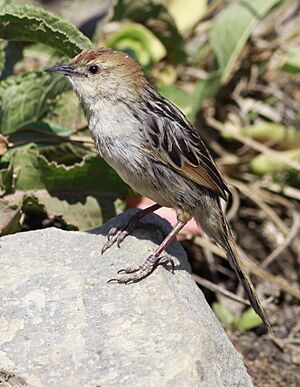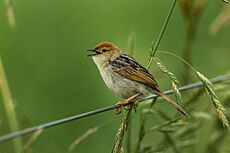Tinkling cisticola facts for kids
Quick facts for kids Levaillant's cisticola |
|
|---|---|
 |
|
| Conservation status | |
| Scientific classification |
The Levaillant's cisticola (Cisticola tinniens) is a small, lively bird. It's also known as the tinkling cisticola because of its calls. This bird lives in wet, marshy areas in the uplands of Africa, south of the equator. It's a type of passerine bird, which means it's a perching bird.
Contents
What Does It Look Like?
The Levaillant's cisticola is a small bird, about 12 to 15 centimeters long. That's roughly the length of a pen! It has a dull color overall, with a slightly long tail and a reddish cap on its head.
Colors and Markings
When it's time to breed, the adult bird's upper body is grey with many black streaks. Its folded wings have a reddish-brown patch. The area above its eye, its face, and its belly are a creamy white color. Its tail is a rusty brown.
Beak and Eyes
The bird has a short, straight beak that is blackish-brown with a pinkish base. Its feet and legs are pinkish-brown, and its eyes are light brown.
Young Birds and Calls
Birds that are not breeding have a browner back. Young birds have yellower feathers on their belly. This cisticola makes several sounds. These include a musical chrip-trrrup-trreee, a sad tee tee tee, and loud alarm calls.
Where Does It Live?
This cisticola lives in eastern Africa, from Kenya all the way to eastern South Africa. It stays in these areas all year round. You can often find it in places with lots of reeds, tall grasses, and other plants that grow near water. It especially likes areas near rivers or dams.
How Does It Behave?
Levaillant's cisticola birds are usually seen in pairs. Sometimes, you might see them alone or in small family groups. They fly quickly through the grass, looking for small insects to eat.
Being Vocal
These birds are quite noisy and easy to spot. They often perch on top of tall grass stems or reeds. From there, they make their alarm calls to warn others.
Reproduction
The cisticola builds a round nest that looks like a ball. It has an opening on the side. The nest is made from dry grass, spiderwebs, and soft plant fluff. They usually place their nest in a clump of grass or weeds. These plants are often standing in or hanging over water. Nesting happens from August to October.
Is It Endangered?
The Levaillant's cisticola is a common bird. It lives across a very large area, estimated to be about 1,400,000 square kilometers. There are many of these birds, so their population is considered large.
Conservation Status
Experts believe the number of these birds is not dropping quickly. Because of this, the species is listed as least concern on the IUCN Red List. This means it is not considered to be at risk of becoming extinct.



